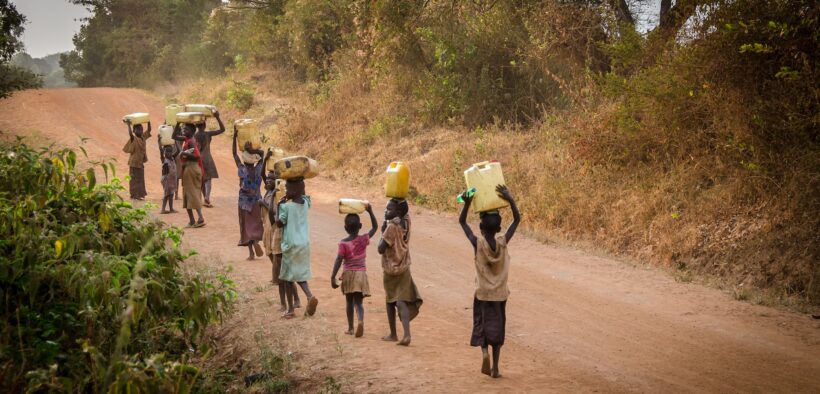Running Out of Time, Water, and Options: US Policy Recommendations for the Climate Migration Crisis
Share

Image Credits: @ackley5 on Unsplash (Unsplash License)
In October 2021 the White House Climate Migration Report was published, marking the first government report on the effects of climate migration. Studies have shown that an average of 6 million people every year move to urban slums in search of work and basic services, including water supplies and basic sanitation. According to the United Nations, water scarcity could displace up to 700 million people by 2030, and as climate change worsens, its impacts will continue to be most felt in the water sector. With climate-dependent livelihoods lost, economic opportunities and growth stagnated, and water resources out of reach, people within these water-stressed regions must join the massive exodus from these regions. While the White House report is comprehensive, the US government cannot end its involvement in climate migration with this publication. International and multilateral organizations such as the International Organization for Migration (IOM) and United Nations High Commissioner for Refugees (UNHCR) have fallen short of providing protections for climate migrants since climate migration exists outside of current refugee frameworks. For the US, current policy only offers temporary solutions for a small number of qualifying individuals against a backdrop of worsening environmental degradation and an ever-growing pool of displaced people. Therefore, the US should evaluate its current immigration policy and consider the implementation of three policy options: reducing the US’s environmental footprint, expanding options for climate migrants under current immigration policies, and increasing international humanitarian assistance.
Current US Immigration Policy
Under current US immigration law, climate migrants are excluded from the protections afforded to refugees and asylum-seekers. Instead, there are four limited statutory provisions that present temporary solutions for climate migrants in or coming to the US: Temporary Protected Status (TPS), Deferred Enforced Departure (DED), Humanitarian Parole, and Compact of Free Association (CFA). According to the 1990 Immigration Act, which provides the statutory provision of TPS, those unable to return to their country of origin due to environmental disasters, ongoing conflict, or extraordinary or temporary conditions can remain and work in the US until it is safe to return. However, TPS has many shortcomings that restrict who qualifies for benefits and the benefits granted to them. First, to qualify, one must be physically present in the US at the time of TPS designation. This holds migrants to a relentless timeline to enter the US that can block pathways out of the environmental disasters that earned them TPS designation. Countries affected by disasters must also officially petition for their nationals to receive TPS status, limiting application possibilities for nationals of countries without sufficient government will or capacity to make these requests. If migrants are able to earn the TPS designation and enter the US in time, they do not qualify for any state or federal welfare assistance. Finally, TPS is by definition temporary and, therefore, provides no permanent solution.
The second option, DED, is most often used once TPS has expired and essentially offers a short stay that allows nationals facing conflict or severe environmental disasters to remain in the US. Humanitarian parole gives the attorney general the authority to grant temporary entry to nationals on a case-by-case basis. In general, parole is granted for only one year, and does not place an individual on a track towards permanent residency or citizenship, nor does it afford them any welfare benefits. Finally, the Compact of Free Association offers indefinite stay but only to citizens from the Federated States of Micronesia, the Republic of Marshall Islands, and Palau.
There is no denying the inadequacy of these four options. Not only are they temporary in nature, but they are so exclusive that their reach and efficacy is diminished. These four options essentially put these migrants on a six or twelve-month trial where US citizenship is not on the table, financial assistance and welfare is not offered, and auto-renewal would be antithetical to the program’s impermanence. As climate change and other environmental disasters continue to drive migration, the US must consider alternative policy options to better and more sustainably protect migrants.
Policy Option #1: Reduction of US Environmental Footprint
The US and other high-income countries in the European Union are responsible for 74% of resource use beyond thresholds of environmental sustainability, and therefore are the primary drivers of global environmental degradation. Individually, the US is one of the leading emitters of GHGs. Therefore, the biggest impact the US can have for climate migrants is to implement sustainable policies. Actions such as restricting GHG emissions, examining fair resource usage, and prioritizing sustainability and resource equitability over industrialization and economic growth are steps the US can take to reduce its environmental footprint and mitigate the effects of climate change that cause climate migration, which in turn, reduce the number of climate migrants.
However, the proposal to reduce the GHG emissions and resource usage that underpins economic growth and industrialization would be a difficult sell to the American people and companies. Economic growth has long been associated with net reduction of poverty, increased access to public goods and services, higher incomes and profits, and more job opportunities. One study revealed that a federal mandate in which 25% of US electricity be generated from renewable sources could total $13 to $45 billion dollars lost to the economy per year. While this economic loss sounds significant, it is minor compared to the economic costs of leaving climate change unchecked. If GHG emissions and climate-related disasters remain unabated, the White House reports that climate change could lead to an annual federal revenue loss of $2 trillion per year. Furthermore, the federal government could spend up to $128 billion annually on coastal disaster relief, flood insurance, crop insurance, healthcare insurance, wildland suppression and flooding at federal facilities. While there are upfront costs of switching to renewable sources of energy and ensuring fair resource use, it is the cheaper decision in the long run.
Policy Option #2: Expand Options for Climate Migrants under Existing US Policy
Rather than absorb climate migrants under the refugee and asylum protections, this policy option recommends restructuring and expanding the options available to climate migrants under existing US policy. To do so, the US should create programs to accommodate temporarily and permanently displaced climate refugees. First, the US should create a version of TPS specifically designed for people temporarily displaced by climate change-related disasters that also applies to those currently outside the US. Additionally, Congress should enact legislation that would authorize the administration to provide migrants a pathway to permanent residence and citizenship who have had TPS status for more than 5 years. Additionally, the US should create a migrant resettlement program for those that are permanently displaced. Similar in operation to current refugee and asylum processes, climate migrants could apply after arriving in the United States or at a U.S. embassy or consulate and would need to demonstrate they had been impacted by a permanent climate displacement event. After being approved, these migrants would be eligible to gain lawful permanent resident status and ultimately for US citizenship. Additionally, the creation of a migrant resettlement program for those permanently displaced makes its participants eligible for lawful permanent resident status, a subset under the “qualified” alien category which enables those who qualify to receive aid from federal and state benefit programs, including Temporary Assistance for Needy Families (TANF), SSI, Medicaid, and the State Children’s Health Insurance Program (SCHIP). Climate migrants would therefore be eligible for programs that aim to help families with limited income and resources as they await permanent US citizenship.
However, the decisions to expand legal pathways for climate migrants would increase the number of climate migrants seeking entrance into the US and the number admitted. While this has the potential to place strain on American cities, public services, and federal budgets, as more refugees are going to cities other than traditional hotspots such as New York and San Francisco, those smaller cities have benefited enormously from the presence of refugees. For example, in Salt Lake City refugees have taken up crucial positions in local restaurants, farms and construction companies that underpin the local economy. At many of these less populated cities, refugees have been praised for bringing diversity, reinvigorating the economy and saving cities with aging and shrinking populations. The increase of climate migrants in the US cannot be generalized as just a negative phenomenon.
Policy Option #3: Increase International Humanitarian Assistance
Humanitarian assistance to countries most vulnerable to climate change is arguably long overdue. As countries in the Global South bear the brunt of severe climate disasters, many of them enter debt crises, taking out loans from multilateral institutions like the IMF or other rich countries, to deal with the aftermath of extreme climate events likely caused by the GHG emission of richer, industrialized nations in the Global North. Research by the Debt Justice group found that the world’s poorest countries spend five times more on debt payments than on dealing with climate change. As the historical top carbon emitter, the US has caused more than $1.9 trillion in climate damage to other countries from 1990 to 2014. By providing increased humanitarian aid and assistance to these countries, the US would be engaging in a form of environmental reparations. This financial assistance would go towards helping these countries take preventative measures against, provide government assistance during, and offer recovery and rehabilitation programs after climate disasters as well as alleviate their debt burden.
One form of this aid is to increase funding towards Disaster Risk Reduction (DRR), a key tool encompassing local, regional, national, and international measures to prevent or reduce the damage resulting from environmental disasters. A similarly beneficial form of aid are Climate Change Adaptation (CCA) programs which focus on future climate change risks and broader aims aligned with sustainable development agendas. DRR and CCA programs include early warning networks, training schoolchildren on what to do when an earthquake strikes, and teaching local emergency personnel how to conduct search-and-rescue. Not only would such programs preventively equip receiving countries with strategies to reduce the number of lives and resources lost when disasters strike, but funding towards the provision of public services (healthcare, social assistance, education, climate-resistant infrastructure, etc.) would increase the resilience of populations living in climate-affected areas, reducing their need to migrate.
Secondly, the US should invest in recovery and rehabilitation programs to help communities after climate-induced disasters. This would involve allocating funding and other federal resources towards building resilient urban systems and ensuring access to job opportunities, healthcare, labor and human protections, and social safety nets to individuals in communities experiencing environmental crises. Such programs would also give people the tools to restart former jobs or the training to pursue alternative sources of income, provide psychological care to traumatized disaster survivors, and prepare individuals to get back on their feet. For example, in many African countries, the Office of U.S. Foreign Disaster Assistance (OFDA) provides mobile cash transfers, allowing people to purchase food or other items to restart small businesses, which directly contribute to the rejuvenation of local economies. These measures reduce the number of those affected by disasters and ensure that those who are affected have social protections to fall back on that help them rebuild their lives.
Conclusion
The ever-growing severity of climate migration can no longer be sidelined, and in order to mitigate the issue best according to national and international interests, the US should reduce its environmental footprint, reform the legal pathways for climate migrants, and provide increased humanitarian aid to communities abroad. In doing so, the US is not only mitigating the stressors that cause climate migration, but providing the immigration policy reform and humanitarian assistance necessary to give currently affected populations avenues towards permanent safety.


Want to get involved?
Connect with us! Connect with us!